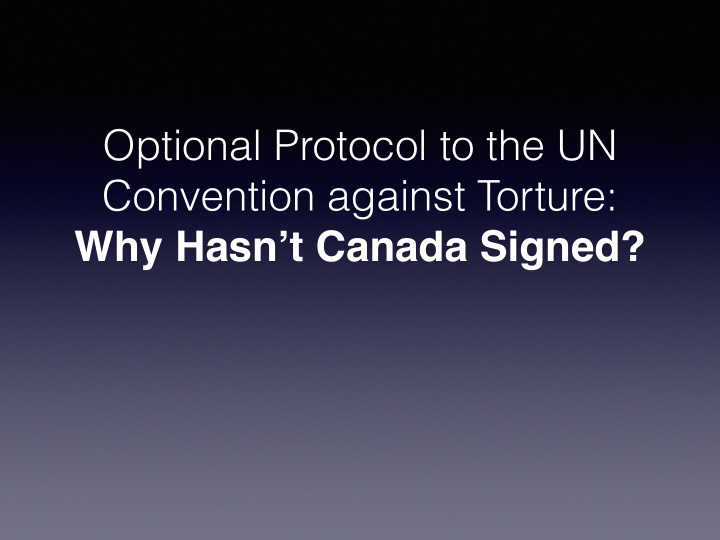



Optional Protocol to the UN Convention against Torture: Why Hasn’t Canada Signed?
What is the Optional Protocol all about? • In 2002, the UN created a convention which requires signatories to allow UN inspections in to national & international prisons in order to “identify and expose conditions that allow torture to take place” • This gives precedent for UN inspectors to announce the conditions in these detention centres for the world to know, and ideally this will improve conditions for imprisoned peoples
Who has signed the protocol? • Over 100 countries have signed, including the Democratic Republic of the Congo, Guatemala, and Mexico • Take it with a grain of salt: notice there are issues here because of many incidents of torture in these signatory countries (e.g. Mexico). However, at the least they are making a combined effort with the UN to combat torture, since their global reputations are often subject to UN discretion • Still, Canada and the United States are on the list of those that haven’t (alongside Afghanistan, Russia, and Thailand among others), raising questions about their complicity in torture within and beyond their borders
[Statistic in the US]
What is happening in Canada’s prisons? • The main torture concern in Canada is solitary confinement • Inhumane conditions which cause excessive anxiety, stress, illness, and often perpetuates suicide • Can occur for days or months at a time • Studies argue that it in fact does not contribute to more positive behaviour in an inmate, rather the opposite • There are 1,800 Canadians in solitary confinement on any given day (Globe and Mail) • “Torture is by no means rampant within Canada. However, solitary confinement…very often amounts to torture. Solitary confinement is used excessively and for extended periods of time within Canadian prisons. The UN Committee against Torture has called on Canada to bring solitary confinement under control. There has been no progress in that direction.”- Amnesty International • The new UN Optional Protocol would minimize the extent of, and ideally eliminate, solitary confinement used as a punishment tool via prison inspections
Who is subject to torture? • Torture is a fear tactic used as a means of dehumanization, and has become the punishment of choice throughout the War on Terror • However, torture practices are common beyond the sphere of terrorism, used in detention centres in Canada and worldwide on a number of criminal suspects, opposition journalists, and human rights defenders • “Most victims of torture and other ill-treatment worldwide are not dangerous terrorists but rather poor, marginalized and disempowered criminal suspects who seldom draw the attention of the media and public opinion, either nationally or globally.” - Amnesty International • Amnesty takes a strong stance that torture is never justified, whatever the motive. Most importantly torture is a form of oppression for dissension.
Eddie Snowshoe • 24 year-old aboriginal man who spent 162 consecutive days in solitary confinement • Committed suicide in his 2.5 x 3.6 meter Solitary Unit at Edmonton Maximum-Security Prison (after 4 previous suicide attempts) • Prison guards and the Correctional Service of Canada ignored all indications of mental health issues, even his previous suicide attempts, and consistently agreed to keep him in solitary for the “sake of others’ safety”. His written requests to be integrated back into the social prison environment were read 3 months after his death. • Again, the use of solitary confinement has not shown to have any improvement on the behaviour of inmates • Bureaucracy of the review committee seriously problematic • Calls to limit the amount of time one can spend in solitary confinement (15 to 60 days) were not followed through • Clear evidence that solitary confinement is ineffective, dehumanizing, physically and mentally abusive, and out of control
What are the implications of being non- signatory as an example to the rest of the world? • Torture within a nation points to even worse tactics abroad • Suspicion and evidence of complicity in other means of torture including but not limited to deportation and torture in various forms (waterboarding, solitary confinement, whipping, etc.) as a war tactic • Canada needs to ratify the Optional Protocol in order to discourage the global community from engaging in acts of torture. • If Canada, as a country whose reputation is quite peaceful, engages in acts of torture, why should they have the authority to call on others to strengthen their human rights record? • Looking at situations like Guantanamo Bay and potential war crimes in Afghanistan, Canada is setting avery hypocritical example as an advanced industrialized democracy
Things to think about.. • Why is the Protocol optional in the first place? • Has the Optional Protocol been effective in preventing torture? Looking at Mexico… • Why are prison punishment norms so difficult to change?
Recommend
More recommend